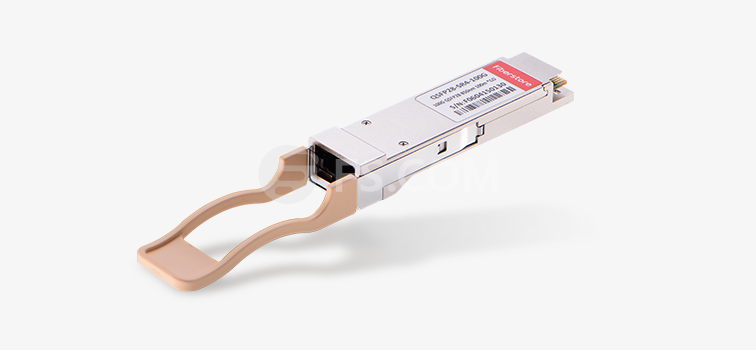QSFP28 fiber optic transceiver is becoming the preferred solution for 100G network. It has the same outside looking as the 40G QSFP+ transceiver. But it has a 4*25G electrical interfaces which can transmit optical signals up to 100G. The part numbers of the QSFP28 transceivers are usually market as 100G-QSFP-xx. Now there is a wide selection of 100G QSFP28 modules for 100G Ethernet link, including fiber optic transceiver and direct attached cable. Different part numbers of 100G modules are making customers confused. This post will introduce the differences between the three 100G QSFP28 modules: 100G-QSFP-PSM4, 100G-QSFP-SR4 and 100G-QSFP-LR4.

It is known that QSFP28 modules generally use four lanes to transmit 100G with each lane supporting 25G. Thus, the transmission method is just like 40G QSFP+ transceiver. 100G QSFP28 SR4, LR4 and PSM4 all use the 4*25 transmission mode. However, both the QSFP28 SR4 and QSFP28 PSM4 use a 12-fiber MTP interface which achieves dual-way 100G transmission over 8 fibers at the same time. QSFP28 LR4 uses a LC duplex fiber optic interface for 100G transmission on two directions at the same time. QSFP28 LR4 transmit optical signals over four different wavelengths around 1310nm with each wavelength carrying 25G optical signal. The wavelength ranges of the four lanes are as following:
- 1294.53nm-1296.59nm
- 1299.02nm-1301.09nm
- 1303.54nm-1305.63nm
- 1308.09nm-1310.19nm
The three modules can support different transmission distances. 100G-SR4 QSFP28 module works over wavelength of 850nm and is used with 12-fiber MTP OM3 or OM4 multimode fiber cables for short transmission distances up to 100m. 100G-LR4 QSFP28 module is suggested to be used with single-mode fiber. It works over 1310nm wavelengths and can transmit 100G signals up to 2km. 100G-PSM4 QSFP28 is also used with 12-fiber MTP fiber cables but the fiber type is single-mode and the transmission distance is up to 500m.

The transmission mode of the fiber optic transceiver plays an important role during fiber cabling. 100G-QSFP-SR4 and 100G-QSFP-LR4 are invented for short distance transmission and long distance transmission separately. However, the have different cabling structure. The former requires a multi-fiber cabling structure based on 12-fiber MMF MTP interfaces. While 100G-QSFP-LR4 just required the traditional two-fiber SMF cabling structure. In this case, the conversion between multimode fiber to single-mode fiber would be complex as they used totally different cabling structure. Thus, 100G-QSFP-PSM4 is invented which runs over single-mode fiber, but uses the same cabling structure as 100G-QSFP-SR4. With 100G-QSFP-PSM4, the conversion between multimode and single-mode would save more without changing the existing fiber cabling structure.
| 100G QSFP28 Transceiver | Data Rate | Interface | Fiber Type | Transmission Distance |
Wavelengths | Cabling Structure |
| 100G-QSFP-SR4 | 4*25G | MTP | MMF | 70m (OM3); 100m (OM4) |
850nm | 12-Fiber MTP |
| 100G-QSFP-LR4 | 4*25G | LC | SMF | 2km | 1310nm | LC Duplex |
| 100G-QSFP-PSM4 | 4*25G | MTP | SMF | 500m | 1310nm | 12-Fiber MTP |
The above table listed the basic information of the three modules for your referent. 100G-QSFP-SR4 are suitable for short distance transmission over OM3 or OM4 fiber using 12-MTP fiber cabling system. 100G-QSFP-PSM4 also has a 12-fiber MTP interface but it can support a transmission distance up to 500m over SMF. 100G-QSFP-LR4 is suitable for long transmission distance up to 2km over two single-mode fibers.
Related Article: 40G vs 100G: Which One Is Worth the Investment?
